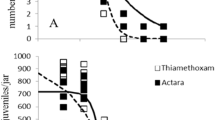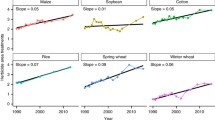Abstract
Current guidelines for phytotoxicity testing rely heavily on short-term testing of primarily crop species to predict the sensitivity of non-target, wild plants to herbicides. However, little is known on how plants recover following initial growth inhibitions in standard 14–28 day greenhouse tests conducted for pesticide assessment and registration. The objectives of this study were to assess the ability of plant species to recover (biomass and reproduction) when tested at the juvenile stage (routine regulatory testing), comparing crop and wild species and using the herbicide glufosinate ammonium. Ten crops and 10 wild species were tested with a one-time exposure to glufosinate ammonium in a greenhouse. Half the plants of each species (9 doses × 6 replicates) were harvested 3 weeks after being sprayed (short-term). The remaining plants were harvested several weeks later, coinciding with seed set or natural senescence (long-term). Total aboveground biomass and several endpoints related to crop production and plant reproduction were measured. Calculated IC50 values (dosage that results in a 50% decrease in the biomass of a plant as compared to the untreated controls) based solely on aboveground biomass, for species harvested in the long-term were generally higher than those obtained in the short-term (with two exceptions), indicating recovery over time. Crop species did not differ from wild species in terms of sensitivity. However, in seven out of 12 cases where reproduction was measurable, reproductive endpoints were more sensitive than either short or long-term biomass endpoints, indicating the importance of examining these parameters in phytotoxicity testing. Glufosinate ammonium was found to be phytotoxic at low doses (2.64–7.74% g ai/ha of the label rate).

Similar content being viewed by others
References
Aldenberg T, Slob W (1993) Confidence limits for hazardous concentrations based on logistically distributed NOEC toxicity data. Ecotoxicol Environ Safe 25:48–63
Al-Khatib K, Claassen MM, Stahlman PW, Geier PW, Regehr DL, Duncan SR, Heer WF (2003) Grain sorghum response to simulated drift to glufosinate, glyphosate, imazethapyr, and sethoxydim. Weed Technol 17:261–265
Anderson DM, Swanton CJ, Hall JC, Mersey BG (1993) The influence of temperature and relative humidity on the efficacy of glufosinate ammonium. Weed Res 33:139–147
Barnthouse LW (2004) Qualifying population recovery rates for ecological risk assessment. Environ Toxicol Chem 23:500–508
Beriault JN, Horsman GP, Devine MD (1999) Phloem transport of D, L-glufosinate and acetyl-L-glufosinate in glufosinate-resistant and -susceptible Brassica napus. Plant Physiol 121:619–627
Bhatti MA, Al-Khatib K, Felsot AS, Parker R, Kadir S (1995) Effects of simulated chlorsulfuron drift on fruit yield and quality of sweet cherries (Prunus avium L.). Environ Toxicol Chem 14(3):537–544
Boutin C, Jobin B (1998) Intensity of agricultural practices and effects on adjacent habitats. Ecol Appl 8(2):544–557
Boutin C, Rogers CA (2000) Pattern of sensitivity of plant species to various herbicides—An analysis with two databases. Ecotoxicology 9:255–271
Boutin C, Lee H-B, Peart T, Batchelor PS, Maguire RJ (2000) Effects of the sulfonylurea herbicide metsulfuron methyl on growth and reproduction of five wetland and terrestrial plant species. Environ Toxicol Chem 19(10):2537–2541
Boutin C, Elmegaard N, Kjaer C (2004) Toxicity testing of fifteen non-crop plant species with six herbicides in a greenhouse experiment: implications for risk assessment. Ecotoxicology 13:349–369
Boutin C, White AL, Carpenter D (2010) Measuring variability in phytotoxicity testing using crop and wild plant species. Environ Toxicol Chem 29(2):327–337
Brammall RA, Higgins VJ (1988) The effect of glyphosate on resistance of tomato to Fusarium crown and root rot disease and on the formation of host structural defensive barriers. Can J Bot 66:1547–1555
Breeze V, Thomas G, Butler R (1992) Use of a model and toxicity data to predict risks to some wild plants species from drift of four herbicides. Ann Appl Biol 121:669–677
Brimble S, Bacchus P, Caux P-Y (2005) Pesticide utilization in Canada: a compilation of current sales and use data. Prepared in fulfillment of a requirement of the Environment Canada Pesticide Program Coordinating Committee. Environment Canada, 142 pp
Clark J, Ortego LS, Fairbrother A (2004) Sources of variability in plant toxicity testing. Chemosphere 57:1599–1612
Coupland RT (1950) Ecology of mixed prairie in Canada. Ecol Monogr 20(4):271–315
Crone EE, Marler M, Pearson DE (2009) Non-target effects of broadleaf herbicide on a native perennial forb: a demographic framework for assessing and minimizing impacts. J Appl Ecol 46:673–682
Environment Canada (2005). Guidance document on application and interpretation of single-species tests in environmental toxicology. Report EPS 1/RM/46. Methods Development and Application Section, Environmental Technology Centre, Environment Canada, Ottawa, Canada
Fawcett RS, Slife FW (1978) Effects of 2, 4-D and dalapon on weed seed production and dormancy. Weed Sci 26(6):543–547
Fletcher JS, Muhitch MJ, Vann DR, McFarlane JC, Benenati FE (1985) Phytotox database evaluation of surrogate plant species recommended by the U.S. environmental protection agency and the Organization for Economic Co-operation and Development. Environ Toxicol Chem 4:523–532
Fletcher JS, Pfleeger TG, Ratsch HC (1995) Chlorsulfuron influence on garden pea reproduction. Physiol Plantarum 94:261–267
Fletcher JS, Pfleeger TG, Ratsch HC, Hayes R (1996) Potential impact of low levels of chlorsulfuron and other herbicides on growth and yield of non-target plants. Environ Toxicol Chem 15(7):1189–1196
Follak S, Hurle K (2004) Recovery of non-target plants affected by airborne bromoxynil-octanoate and metribuzin. Weed Res 44:142–147
Freedman B, Morash R, MacKinnon D (1993) Short-term changes in vegetation after the silvicultural spraying of glyphosate herbicide onto regenerating clearcuts in Nova Scotia, Canada. Can J For Res 23:2300–2311
Hume L (1987) Long-term effects of 2, 4-D application on plants. I. Effects on the weed community in a wheat field. Can J Bot 65:2530–2536
Kegode GO, Fronning BE (2005) Artemisia biennis (biennial wormwood) control is influenced by plant size and weed flora at time of herbicide application. Crop Prot 24:915–920
Khan M, Donald WW (1992) Sulfonylurea herbicides reduce survival and seed production of green and yellow foxtails (Setaria spp.). Weed Tech 6(2):284–290
Kjær C, Strandberg M, Erlandsen M (2006) Metsulfuron spray drift reduces fruit yield of hawthorn (Crataegus monogyna L.). Sci Total Environ 356:228–234
Lacuesta M, Muñoz-Rueda A, González-Murua C, Sivak MN (1992) Effect of phosphinothricin (glufosinate) on photosynthesis and chlorophyll fluorescence emission by barley leaves illuminated under photorespiratory and non-photorespiratory conditions. J Exp Bot 43(247):159–165
Lea PJ, Ridley SM (1989) Glutamine synthetase and its inhibition. In: Dodge AD (ed) Herbicides and Plant Metabolism. Cambridge University Press, Cambridge, UK, pp 137–170
Malone CR (1972) Effects of a non-selective arsenical herbicide on plant biomass and community structure in a fescue meadow. Ecology 53(3):507–512
Marrs RH (1985) The effects of potential bracken and scrub control herbicides on lowland Calluna and grass heath communities in East Anglia, UK. Biol Conserv 32:13–32
Marrs RH, Williams CT, Frost AJ, Plant RA (1989) Assessment of the effects of herbicide spray drift on a range of plant species of conservation interest. Environ Pollut 59:71–86
Marrs RH, Frost AJ, Plant RA (1991a) Effects of herbicide spray drift on selected species of nature conservation interest: the effects of plant age and surrounding vegetation. Environ Pollut 69:223–235
Marrs RH, Frost AJ, Plant RA (1991b) Effect of mecoprop drift on some plant species of conservation interest when grown in standardized mixtures in microcosms. Environ Pollut 73:25–42
McKelvey RA, Wright JP, Honegger JL (2002) A comparison of crop and non-crop plants as sensitive indicator species for regulatory testing. Pest Manag Sci 58:1161–1174
Merkel U, Rathke G-W, Schuster C, Warnstorff K, Diepenbrock W (2004) Use of glufosinate-ammonium to control cruciferous weed species in glufosinate-resistant winter oilseed rape. Field Crop Res 85:237–249
Norberg-King TJ (1993) A linear interpolation method for sublethal toxicity: the inhibition concentration (ICp) approach (version 2.0). Technical Report 03-93. U.S. Environmental Protection Agency, Environmental Research Laboratory, Duluth, MN
Olszyk D, Pfleeger T, Lee EH, Burdick C, King G, Plocher M, Kern J (2008) Selecting and evaluating native plants for region-specific phytotoxicity testing. Integr Environ Assess Manag 4(1):105–117
Organisation for Economic Co-operation and Development (OECD) (2006) Terrestrial Plants, Growth Test no. 208 and no. 227. OECD Guidelines for Testing Chemicals, Paris, France
Pestemer W, Zwerger P (1999) Application of a standardized bioassay to estimate the phytotoxic effects of frequently used herbicides on non-target plants. XI. Symposium Pesticide Chemistry—Human and Environmental Exposure to Xenobiotics. Cremona, pp 763–770
Pfleeger T, Zobel D (1995) Organic pesticide modification of species interactions in annual plant communities. Ecotoxicology 4:15–37
Pfleeger T, Olszyk D, Plocher M, Yilma S (2008) Effects of low concentrations of herbicides on full-season, field-grown potatoes. J Environ Qual 37:2070–2082
Pline WA, Wu J, Hatzios KK (1999) Absorption, translocation, and metabolism of glufosinate in five weed species as influenced by ammonium sulphate and pelargonic acid. Weed Sci 47:636–643
Riemens MM, Uffing A, Kempenaar C, Dueck T (2004) Effects of two herbicides and one fungicide on field margins. Continuation of a study with the EPOP-model. Note 329. Plant Research International B.V., Wageningen. http://library.wur.nl/way/bestanden/clc/1746437.pdf. Accessed 12 March 2010
Riemens MM, Dueck T, Kempenaar C (2008) Predicting sublethal effects of herbicides on terrestrial non-crop plant species in the field from greenhouse data. Environ Pollut 155:141–149
Riemens MM, Dueck T, Kempenaar C, Lotz LAP, Kropff MJJ (2009) Sublethal effects of herbicides on the biomass and seed production of terrestrial non-crop plant species, influenced by environment, development stage and assessment date. Environ Pollut 157:2306–2313
Schmenk R, Kells JJ (1998) Effects of soil-applied atrazine and pendimethalin on velvetleaf (Abutilon theophrasti) competitiveness in corn. Weed Technol 12(1):47–52
Siimes K, Rämö S, Welling L, Nikunen U, Laitinen P (2006) Comparison of the behaviour of three herbicides in a field experiment under bare soil conditions. Agri Water Manage 84:53–64
Skora Neto F, Coble HD, Corbin FT (2000) Absorption, translocation, and metabolism of 14C-glufosinate in Xanthium strumarium, Commelina diffusa, and Ipomoea purpurea. Weed Sci 48:171–175
Steckel GJ, Hart SE, Wax LM (1997) Absorption and translocation of glufosinate on four weed species. Weed Sci 45:278–381
Strong WL, Sidhu SS (2005) Prolonged herbicide-induced vegetation changes in a regenerating boreal aspen clearcut. J Environ Manage 77:194–204
Taylor SE, Oliver LR (1997) Sicklepod (Senna obtusifolia) seed production and viability as influenced by late-season postemergence herbicide applications. Weed Sci 45(4):497–501
Tharp BE, Schabenberger O, Kells JJ (1999) Response of annual weed species to glufosinate and glyphosate. Weed Technol 13(3):542–547
United States Environmental Protection Agency (USEPA) (1996) Ecological Effects Test Guidelines: Terrestrial Plant Toxicity—Vegetative Vigor, OPPTS 850.4150. EPA 712-C-96-163. Washington, DC
Wang W, Freemark K (1995) The use of plants for environmental monitoring and assessment. Ecotoxicol Environ Safe 30:289–301
Weiner J (1990) Asymmetric competition in plant populations. Trends Ecol Evol 5(11):360–364
Wendler C, Barniske M, Wild A (1990) Effect of phosphinothricin (glufosinate) on photosynthesis and photorespiration of C3 and C4 plants. Photosynth Res 24:55–61
White AL, Boutin C, Dalton RL, Henkelman B, Carpenter D (2009) Germination requirements for 29 terrestrial and wetland wild plants species appropriate for phytotoxicity testing. Pest Manag Sci 65(1):19–26
Acknowledgements
This study was funded by the Pesticide Science Fund of Environment Canada. The authors would like to thank D. François and P. Smith for helpful comments and E. Bruggink for the use of additional greenhouse space.
Author information
Authors and Affiliations
Corresponding author
Rights and permissions
About this article
Cite this article
Carpenter, D., Boutin, C. Sublethal effects of the herbicide glufosinate ammonium on crops and wild plants: short-term effects compared to vegetative recovery and plant reproduction. Ecotoxicology 19, 1322–1336 (2010). https://doi.org/10.1007/s10646-010-0519-7
Accepted:
Published:
Issue Date:
DOI: https://doi.org/10.1007/s10646-010-0519-7




